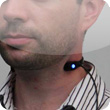|

Year: 2010-
Member:
Masahiro Nagae
Kenji Suzuki
Partners:
- University Hospital
(Neurosurgery)
- Related Hospital
Tags:
- Cybernics
- Augmented Human
|
|
Swallowscope
A Neck Mounted Interface for Sensing the Swallowing Activity based on Swallowing Sound
|
|
|
|
This study proposes a novel interface which is mounted on the back of neck, for sensing swallowing activities based on the sound produced when swallowing. Recently, due to the aging of the population, the number of dysphagia patients has been increasing. Although various types of diacrisis and dysphagia testing methodologies already exist, several problems remain. For example, the videofluorography methodology requires long preparation, presents risks of aspiration, demands knowledge about diacrisis and must be performed in a medical facility. This study introduces a wearable sensing system which can be used in a daily life environment. As it gives direct real time information in regards of the swallowing movements, this devices also aims at being used for rehabilitation purposes. The proposed system uses a new evaluation technic based on the duration of the swallowing action.
We introduce an interface that is able tomeasure the sound, allowing the record of the swallowing activity in real-time. The interface is to be mounted on the back of the neck and does not interfer with the patient’s natural behavior. The information of whether swallowing happens normally or not is very important for efficient rehabilitation. The purpose of this work is two folds: (1) to evaluate the information of swallowing activity in real time and (2) to improve improving the rehabilitation of dysphagia by having patients evaluating their condition by themselves by getting the index of their swallowing activity.
We proposed a novel method for the evaluation of the swallowing activity by means of acoustic analysis. We developed an interface to be mounted at the back of the neck which evaluates swallowing activities which is a normally hidden physiological activity. Experiments were conducted to measure the reliability of the proposed device. Contrary to already existing methods, the proposed interface is non invasive and can be used in a normal daily life situation. By displaying in real-time information about swallowing actions, the device also aims at being an efficient rehabilitation tool. In the future, work aiming at providing more detailed abstraction of the swallowing sound characteristics will be conducted, in order to give more precise information about the conditions of the swallowing action and to predict possible aspiration. We also plan on developing an interface using functional electric stimulation for restablishing normal eating conditions to dysphagia patients.
|
|

This work is partly supported by Grants-in-Aid for Scientific Research, MHLW, Japan.

This work is partly supported by FIRST Program: World leading Human-Assistive Technology.
|
| |
|
|
|
Publications
- Suzuki, K., Jayatilake, D., Teramoto, Y., Ueno, T., Nakai, K., Hidaka, K., Ayuzawa, S., Eguchi, K., and Matsumura, A., "Comprehensive Analysis of Pharyngeal Pressure Trace from High-Resolution Manometry," 2014 Dysphagia Research Society Annual Meeting, 2014 (accepted)
- Teramoto, Y., Ueno, T., Jayatilake, D., Suzuki, K., Nakai, K., Hidaka, K., Ayuzawa, S., Eguchi, K., and Matsumura, A., "Examination of Swallowing Sound by the Simultaneous Recording of Videofluoroscopy and High-resolution Manometory," 2014 Dysphagia Research Society Annual Meeting, 2014 (accepted)
- Nagae, M., and Suzuki, K., "A Neck Mounted Interface for Sensing the Swallowing Activity based on Swallowing Sound," Proc. of Annual International Conference of the IEEE EMBS, pp. 5224-5227, 2011.
|
|
|
| |
|
|
|
Related Projects
Cybernics / Augmented Human
|
|
|
|



